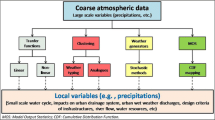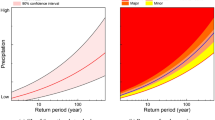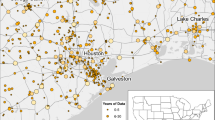Abstract
With climate change concerns, the question arises as to whether precipitation is changing with time. This has implications for the design of water infrastructure and hydraulic structures. The question of whether it is necessary to enlarge water infrastructure in the future has safety and cost implications, with larger budgets required in the future. To investigate the non-stationarity of precipitation, this paper analyzes all the precipitation records for the entire period of record for approximately 100 of the most populated cities, both in the USA and throughout the world. In particular, the 10-year and 100-year return period precipitation magnitudes were calculated marching through time to see if they are changing. The 10-year return period is commonly used as a design flow for small structures, while the 100-year precipitation is used for larger structures and flooding concerns. It was found that for some cities, both the 10- and 100-year precipitation magnitudes were both increasing, while for other cities, both were decreasing. Similarly, there was a lesser number of cities for which one or the other was increasing and the other decreasing. Results are presented on a newly introduced structure enlargement plot (SEP) that shows each category of city precipitation trends in a separate quadrant for easy visualization of both trend and magnitude. It was found that Dhaka, Bangladesh had the highest increase of both the 10- and 100-yar events, therefore indicating the need to enlarge both small and big water infrastructure. Houston had the largest in the USA. Conversely, Ho Chi Min City, Vietnam (Portland for the USA) had the most negative increase of both measures, thereby indicating no need for either small or large water infrastructure.










Similar content being viewed by others
Data availability
The datasets generated during and/or analyzed during the current study are available from the corresponding author on reasonable request.
References
Ahmadi S, Ghorbanpour S (2021) Smart controlling cyanide emissions from surface water resources by predictive models: an integrated GA-regression. J Res Sci Eng Technol 9(01):38–49
Arnbjerg-Nielsen K (2012) Quantification of climate change effects on extreme precipitation used for high resolution hydrologic design. Urban Water J 9(2):57–65. https://doi.org/10.1080/1573062X.2011.630091
Burn DH, Taleghani A (2012) Estimates of changes in design rainfall values for Canada. Hydrol Process 27(11):1590–1599. https://doi.org/10.1002/hyp.9238
CarbonBrief (2020). Jet stream: is climate change causing more ‘blocking’ weather events? https://www.carbonbrief.org/jet-stream-is-climate-change-causing-more-blocking-weather-events/
CC (2022) Climate Center. https://climatecenter.fsu.edu/products-services/data/precipitation/miami
Cheng L, AghaKouchak A (2014) Nonstationary precipitation intensity-duration-frequency curves for infrastructure design in a changing climate. Sci Rep 4:7093. https://doi.org/10.1038/srep07093
CJW (2022) JCWeather. https://jcweather.com/100rainytd.php
Climate Explorer (2023). Starting point. https://climexp.knmi.nl/start.cgi?id=someone@somewhere
Collier M, Web RH (2002) Floods, droughts, and climate change. University of Arizona Press, Tucson
CPC (2022) Custom puzzle craft. https://www.custompuzzlecraft.com/Weather/sandiegorain.html
DeGaetano AT (2009) Time-dependent changes in extreme-precipitation return-period amounts in the continental United States. J Appl Meteorol Climatol. https://doi.org/10.1175/2009JAMC2179.1
ETW (2022) ET weather. https://etweather.tamu.edu/rainhistory
EWW (2022a) Extreme weather watch. https://www.extremeweatherwatch.com/cities/houston,
EWW (2022b) Extreme weather watch. https://www.extremeweatherwatch.com/cities/phoenix
EWW (2022c) Extreme weather watch. https://www.extremeweatherwatch.com/cities/san-antonio
EWW (2022d) Extreme weather watch. https://www.extremeweatherwatch.com/cities/denver
EWW (2022e) Extreme weather watch. https://www.extremeweatherwatch.com/cities/san-jose
EWW (2022f) Extreme weather watch. https://www.extremeweatherwatch.com/cities/jacksonville
EWW (2022g) Extreme weather watch. https://www.extremeweatherwatch.com/cities/columbus
EWW (2022h) Extreme weather watch. https://www.extremeweatherwatch.com/cities/charlotte
EWW (2022i) Extreme weather watch. https://www.extremeweatherwatch.com/cities/indianapolis
EWW (2022j) Extreme weather watch. https://www.extremeweatherwatch.com/cities/seattle
EWW (2022k) Extreme weather watch. https://www.extremeweatherwatch.com/cities/washington-dc
EWW (2022l) Extreme weather watch. https://www.extremeweatherwatch.com/cities/oklahoma-city
EWW (2022m) Extreme weather watch. https://www.extremeweatherwatch.com/cities/nashville
EWW (2022n) Extreme weather watch. https://www.extremeweatherwatch.com/cities/boston
EWW (2022o) Extreme weather watch. https://www.extremeweatherwatch.com/cities/portland-or
EWW (2022p) Extreme weather watch. https://www.extremeweatherwatch.com/cities/las-vegas
EWW (2022q) Extreme weather watch. htps://www.extremeweatherwatch.com/cities/Memphis
EWW (2022r) Extreme weather watch. https://www.extremeweatherwatch.com/cities/detroit
EWW (2022s) Extreme weather watch. https://www.extremeweatherwatch.com/cities/milwaukee1
EWW (2022t) Extreme weather watch. https://www.extremeweatherwatch.com/cities/albuquerque
EWW (2022u) Extreme weather watch. https://www.extremeweatherwatch.com/cities/fresno
EWW (2022v) Extreme weather watch. https://www.extremeweatherwatch.com/cities/tucson
EWW (2022w) Extreme weather watch. https://www.extremeweatherwatch.com/cities/sacramento
EWW (2022x) Extreme weather watch. https://www.extremeweatherwatch.com/cities/kansas-city
EWW (2022y) Extreme weather watch. https://www.extremeweatherwatch.com/cities/atlanta
EWW (2022z) Extreme weather watch. https://www.extremeweatherwatch.com/cities/omaha
EWW (2022aa) Extreme weather watch. https://www.extremeweatherwatch.com/cities/colorado-springs
EWW (2022ab) Extreme weather watch. https://www.extremeweatherwatch.com/cities/raleigh
EWW (2022ac) Extreme weather watch. https://www.extremeweatherwatch.com/cities/virginia-beach
EWW (2022ad) Extreme weather watch. https://www.extremeweatherwatch.com/cities/oakland
EWW (2022ae) Extreme weather watch. https://www.extremeweatherwatch.com/cities/minneapolis
EWW (2022af) Extreme weather watch. https://www.extremeweatherwatch.com/cities/tulsa
EWW (2022ag) Extreme weather watch. https://www.extremeweatherwatch.com/cities/bakersfield
EWW (2022ah) Extreme weather watch. https://www.extremeweatherwatch.com/cities/wichita
FEMA (2019). Fact sheet: myths and facts about flood insurance. federals emergency management agency. https://www.fema.gov/press-release/20230425/fact-sheet-myths-and-facts-about-flood-insurance
Fowler AM, Hennessy KJ (1995) Potential impacts of global warming on the frequency and magnitude of heavy precipitation. Nat Hazards 11:283–303. https://doi.org/10.1007/BF00613411
Gentilucci M, Barbieri M, Burt P, D’Aprile F (2018) Preliminary data validation and reconstruction of temperature and precipitation in Central Italy. Geosciences 8(6):202. https://doi.org/10.3390/geosciences8060202
GGW (2022). GG Weather. https://ggweather.com/sf/monthly.html
LAA (2022). Los Angeles Almanac. https://www.laalmanac.com/weather/we13.php
Martel JL, Brissette FP, Lucas-Picher P, Troin M, Arsenault R (2021) Climate change and rainfall intensity–duration–frequency curves: overview of science and guidelines for adaptation. J Hydrol Eng. https://doi.org/10.1061/(ASCE)HE.1943-5584.0002122
Minh D, Oo AT, Sovanndara K (2023) Farm households’ vulnerability to climate change in Cambodia, Myanmar, and Vietnam: an advanced livelihood vulnerability indexing approach. Asian J Agric Rural Dev 13(1):75–90. https://doi.org/10.55493/5005.v13i1.4768
Ponce VM (2008) On the return period to be used in design. https://ponce.sdsu.edu/return_period.html
RTF (2023) 50 most populated cities in the world. https://www.re-thinkingthefuture.com/2022/09/30/a8004-50-most-populated-cities-in-the-world/
Sung JH, Kang DH, Seo Y-H, Kim BS (2023) Analysis of extreme rainfall characteristics in 2022 and projection of extreme rainfall based on climate change scenarios. Water (switzerland). https://doi.org/10.3390/w15223986
Towoju OA, Petinrin MO (2023) Climate change mitigation with carbon capture: an overview. Int J Sustain Energy Environ Res 12(1):1–9. https://doi.org/10.18488/13.v12i1.3327
Trenberth KE (2005) The impact of climate change and variability on heavy precipitation, floods, and droughts. Encyclopedia of hydrological sciences, https://www2.cgd.ucar.edu/staff/trenbert/books/EHShsa211.pdf
UN (2023) United Nations, Department of Economic and Social Affairs, Sustainable Development. https://sdgs.un.org/goals
USGS (2018). Flood and recurrence Intervals. US Geological Survey. https://www.usgs.gov/special-topics/water-science-school/science/floods-and-recurrence-intervals
WC (2022a) Weather channel. https://www.weather.gov/okx/CentralParkHistorical
WC (2022b) Weather channel. https://www.weather.gov/lot/Annual_Precip_Rankings_Chicago
WC (2022c) Weather channel. https://www.weather.gov/fwd/dmoprecip
WC (2022d) Weather channel. https://www.weather.gov/epz/elpaso_monthly_precip_annual
WC (2022e) Weather channel. https://www.weather.gov/media/lwx/climate/bwiprecip.pdf
Willems P (2013) Revision of urban drainage design rules after assessment of climate change impacts on precipitation extremes at Uccle, Belgium. J Hydrol 496(24):166–177. https://doi.org/10.1016/j.jhydrol.2013.05.037
WPR (2022) World population review. https://worldpopulationreview.com/us-cities
Wurbs RA, James WP (2001) Water resources engineering. Prentice Hall, Upper Saddle River
Author information
Authors and Affiliations
Corresponding author
Ethics declarations
Conflict of interest
The author(s) declare no competing interests.
Ethics statement
This research does not involve any human or animal subjects.
Additional information
Publisher's Note
Springer Nature remains neutral with regard to jurisdictional claims in published maps and institutional affiliations.
Rights and permissions
Springer Nature or its licensor (e.g. a society or other partner) holds exclusive rights to this article under a publishing agreement with the author(s) or other rightsholder(s); author self-archiving of the accepted manuscript version of this article is solely governed by the terms of such publishing agreement and applicable law.
About this article
Cite this article
Barkdoll, B.D. The rain, it is a changing: non-stationarity of precipitation and the effect on water infrastructure design. Sustain. Water Resour. Manag. 10, 86 (2024). https://doi.org/10.1007/s40899-024-01058-7
Received:
Accepted:
Published:
DOI: https://doi.org/10.1007/s40899-024-01058-7




